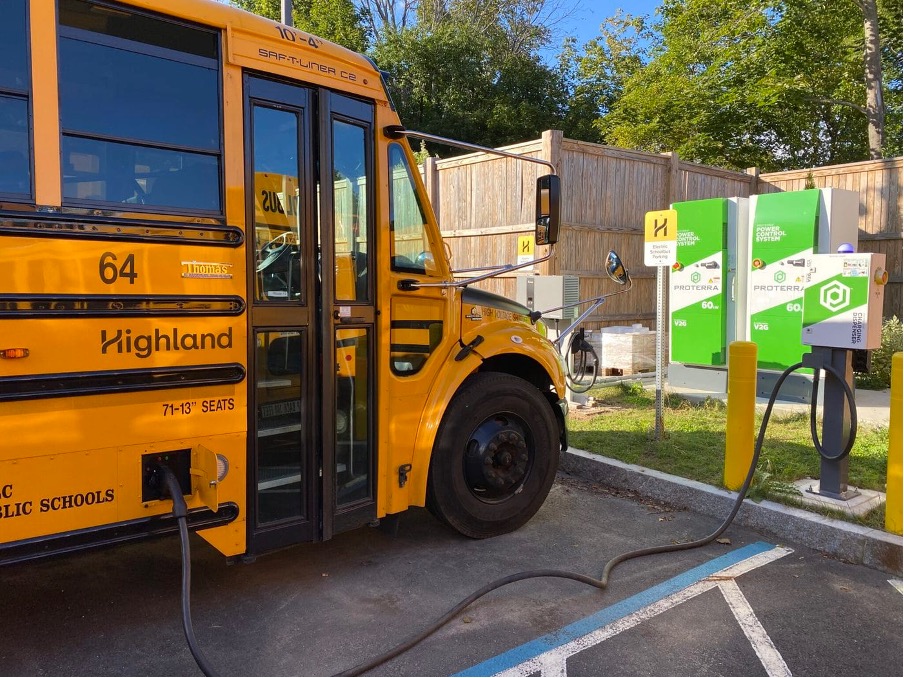By Swati Sonal
One of the most memorable experiences from my school days growing up was riding on school buses. I remember the race to get a window seat and saving the nearby spot for friends while the yellow vehicle carried us to and from school, gently swaying and occasionally bumping across town. However, apart from the fun rides, I also remember breathing lungsful of diesel fumes almost every day as we rolled down the windows for fresh air.
 School buses are the largest contributor to the US public transportation network, with approximately 480,000 buses transporting at least 21 million children daily. In Massachusetts alone, 500,000 children are carried by school buses daily[i]. Currently, 95 % of these buses are fuelled by diesel despite its known contribution to children’s ill-health and environmental pollution. Diesel exhaust contains gaseous and particulate pollutants such as nitrous oxide, sulphur dioxide, polycyclic aromatic hydrocarbons, formaldehyde, ozone and black carbon etc., often with a higher concentration inside the bus than in ambient surroundings[ii]. Children are particularly vulnerable due to their higher breathing rate, active growth, and smaller airway size, where particulate matter <2.5µm tends to get lodged. Exposure to diesel exhaust has been linked to asthma, allergies, future infections, long-term poor lung function, and poor neurocognitive development such as IQ and memory to rare cancers[iii]. Children in low-income neighbourhoods are disproportionately affected as the funding decisions for cleaner alternatives are often based on economic indicators of school districts[iv].
School buses are the largest contributor to the US public transportation network, with approximately 480,000 buses transporting at least 21 million children daily. In Massachusetts alone, 500,000 children are carried by school buses daily[i]. Currently, 95 % of these buses are fuelled by diesel despite its known contribution to children’s ill-health and environmental pollution. Diesel exhaust contains gaseous and particulate pollutants such as nitrous oxide, sulphur dioxide, polycyclic aromatic hydrocarbons, formaldehyde, ozone and black carbon etc., often with a higher concentration inside the bus than in ambient surroundings[ii]. Children are particularly vulnerable due to their higher breathing rate, active growth, and smaller airway size, where particulate matter <2.5µm tends to get lodged. Exposure to diesel exhaust has been linked to asthma, allergies, future infections, long-term poor lung function, and poor neurocognitive development such as IQ and memory to rare cancers[iii]. Children in low-income neighbourhoods are disproportionately affected as the funding decisions for cleaner alternatives are often based on economic indicators of school districts[iv].
Transitioning our school bus fleets to zero emission electric buses is good for our children, climate, and public health. They are healthier and safer for children and drivers, cleaner for the environment, quieter, and have lower life cycle costs compared to their fossil fuel counterparts. Electric school buses can also be used as an energy resource when not in use through vehicle-to-grid technology[v].While the higher up-front costs of electric buses are offset by lower fuelling and maintenance costs over their lifetime[vi], price has remained a bottleneck for adoption by school districts.
However, several federal and state funding programs are making it easier for school districts to make that switch. The Environmental Protection Agency’s (EPA) Clean School Bus Program is providing up to $5 billion in support through 2022-2026 to replace diesel school buses with clean and zero-emission models. This year’s cycle provides $500 million in funding and allows school districts to apply for up to 25 electric buses, with additional funding available for charging infrastructure installations[vii]. Twenty-four priority school districts in the Commonwealth will receive higher level of funding and preference during the selection process. The EPA is accepting applications for the Clean Bus Program until August 19, 2022. The Massachusetts Clean Energy Center (MassCEC) is also offering electrification planning support to school districts through their $8 million Accelerating Clean Transport (ACT) Bus Program, further complementing federal funding[viii]. School districts can also apply for funding to procure electric school buses through the competitive Diesel Emissions Reduction Act (DERA) program. Applications are open until August 24, 2022.
In Massachusetts, electric school buses have already hit the road in several cities. Boston has committed to electrifying its entire school bus fleet by 2030 as part of the city’s Green New Deal[ix] and electric school buses are in operation in Beverly, Cambridge, Concord, and Arlington. Ask your school district to make use of the record federal and state investments available to support this transition! This campaign toolkit has resources to help you get started.
Swati Sonal is a Sierra Club volunteer and a physician-scientist interested in surgery, cancer research and public health.
[i] Download - U.S. State by State Transportation Statistics 2018-19 - Research - U.S. State by State Transportation Statistics 2018-19 [Internet]. [cited 2022 Jul 4]. Available from: https://www.schoolbusfleet.com/research/download?id=10131920
[ii] Sabin LD, Behrentz E, Winer AM, Jeong S, Fitz DR, Pankratz DV, et al. Characterizing the range of children’s air pollutant exposure during school bus commutes. J Expo Anal Environ Epidemiol. 2005 Sep;15(5):377–87.
[iii] Weir E. Diesel exhaust, school buses and children’s health. CMAJ. 2002 Sep 3;167(5):505.
[iv] Gao HO, Klein RA. Environmental equity in funding decisions of the clean air school bus program: The case of New York State. Transportation Research Part D: Transport and Environment. 2011 Jan;16(1):10–4.
[v] Electric School Buses | Dominion Energy [Internet]. [cited 2022 Jul 4]. Available from: https://www.dominionenergy.com/our-stories/electric-school-buses
[vi] Paying for Electric Buses | U.S. PIRG [Internet]. [cited 2022 Jul 4]. Available from: https://uspirg.org/reports/usp/paying-electric-buses
[vii] School Bus Rebates: Clean School Bus Program | US EPA [Internet]. [cited 2022 Jul 4]. Available from: https://www.epa.gov/cleanschoolbus/school-bus-rebates-clean-school-bus-program
[viii] Boston will move to 100% electric school buses by 2030 - Electrek [Internet]. [cited 2022 Jul 4]. Available from: https://electrek.co/2022/04/13/boston-will-move-to-100-electric-school-buses-by-2030/
[ix] Accelerating Clean Transportation School Bus (ACT School Bus) | MassCEC [Internet]. [cited 2022 Jul 4]. Available from: https://www.masscec.com/accelerating-clean-transportation-school-bus-act-school-bus